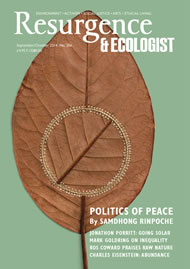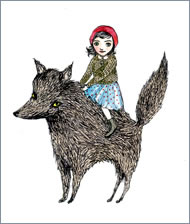A recent wildlife series on British television followed some small birds over three weeks as they nested, laid eggs and raised their chicks. One episode included a gory incident: some crows raided the nest of a particularly appealing bird, killing and eating the chicks. This led to the presenter explaining that although corvids (the crow family) have had a sinister reputation, associated in some mythology with death and darkness, their behaviour should be seen in the wider ecological context. They resort to an opportunistic kill when a food source presents itself, but what they mainly do is the very unscary job of clearing up dead and decaying material.
Many such species have been reviled in mythology – wolves, vultures, hyenas, rats, foxes, bats, to name but a few. But now environmentalists emphasise their role in the wider ecology, dismissing earlier thinking as projections of human social fears onto the natural world: these creatures were ‘evil’, a source of horror, because they appeared to break social taboos – some hunted sneakily at night, some associated with dead flesh, some had ‘excessive’ sexual appetites or particularly disgusting (i.e. non-human) habits. Richard Dawkins, the evolutionary biologist, recently criticised this mythologising by suggesting that fairy tales with their supernatural versions of Nature were damagingly irrational.
But while we no longer need ‘evil creatures’, do we need to shun any suggestion of a darker side of Nature? I raise this because there are some who, equally emphatic about ecological interrelatedness, are at ease with using Nature’s darker side as a source of metaphor. This is in the areas of natural play and ecological psychology.
American writer Richard Louv’s book Last Child in the Woods argues that children suffer from ‘Nature-deficit disorder’, needing to rediscover unstructured play in Nature. In the UK, Tim Gill advances similar ideas. Their main focus is on the value of play in Nature to foster self-reliance, confidence and creativity. Environmental psychologist Louise Chawla observes that playful immersion in Nature is also often a precursor for the development of environmental activism.
But all hint at another value: this freedom also feeds the imagination, allowing children to “create their own play and enter Nature through their own imaginations”, as Louv puts it. Ecological psychology fleshes this out: free play in Nature helps the healthy integration of the personality. Children don’t just gain scientific knowledge and self-reliance, but also use what they witness to process feelings through the imagination. Witnessing the range of natural behaviour, including that which seems scary, revolting and random, provides vital metaphors for life, as does having access to a variety of natural locations. Secret places, scary places and tranquil places provide children with metaphors for their range of emotions.
Richard Kerridge’s book Cold Blood is ostensibly about the ecology and cultural place of amphibians. But it is also a personal memoir about childhood contact with Nature. Fascinated by amphibians, he learned everything he could about them, and this fascination – love – fed his escapism. He also learned about sex, violence and horror, as when he discovered a toad infected by toad fly. He gives graphic details of the fly laying its eggs on the toad’s back. The eggs hatch into maggots, which crawl into the toad’s nostrils, where they “settle and begin eating their way through the nostril walls in all directions, reaching the brain after several days”. Kerridge concludes: “Nowadays, we do not consider some animals to be demonic, but if ever there was a candidate for rational demonisation, the toad fly is one. Yes, the fly is merely reproducing in its evolved fashion. Yes, it has found an ecological niche, a livelihood. But what a truly dreadful niche it is.”
I like this term ‘rational demonisation’, which allows for scientific rationalism but also acknowledges repulsion. Even Dawkins rowed back from his apparent blanket dismissal of fairy tales, admitting they probably aren’t harmful. Quite right, because fairy tales often reflect that Nature can indeed provoke feelings of dread. Like human life itself, Nature is redolent with arbitrary death, accidents, fear, failure of resources, and remorseless instinctive behaviour. Children free to observe Nature closely witness this and process it as part of life through their imagination. So when the crows snatch the chicks, it shouldn’t make us hate them as evil or fear them as a threat. But nor is it out of order to shudder.








